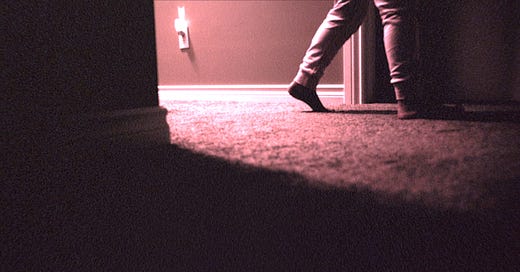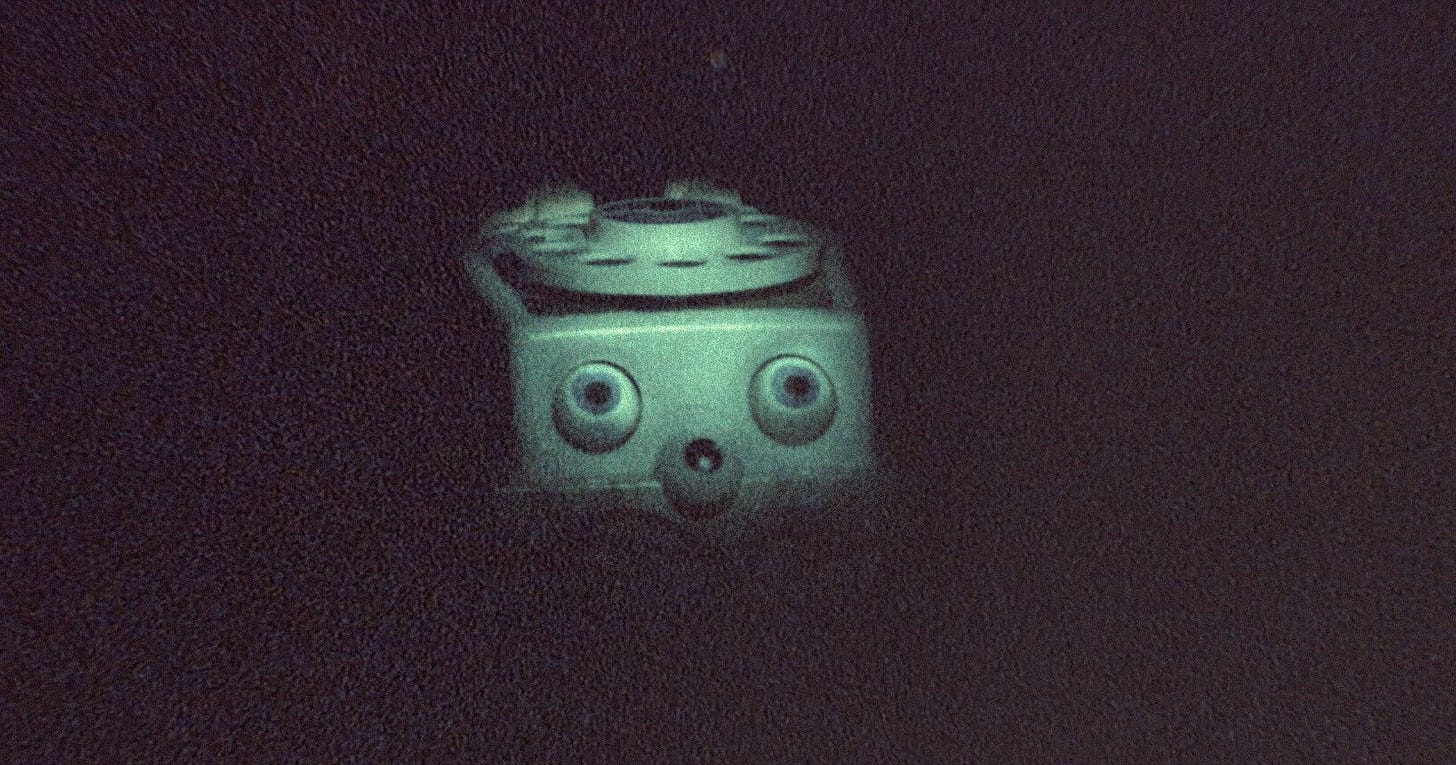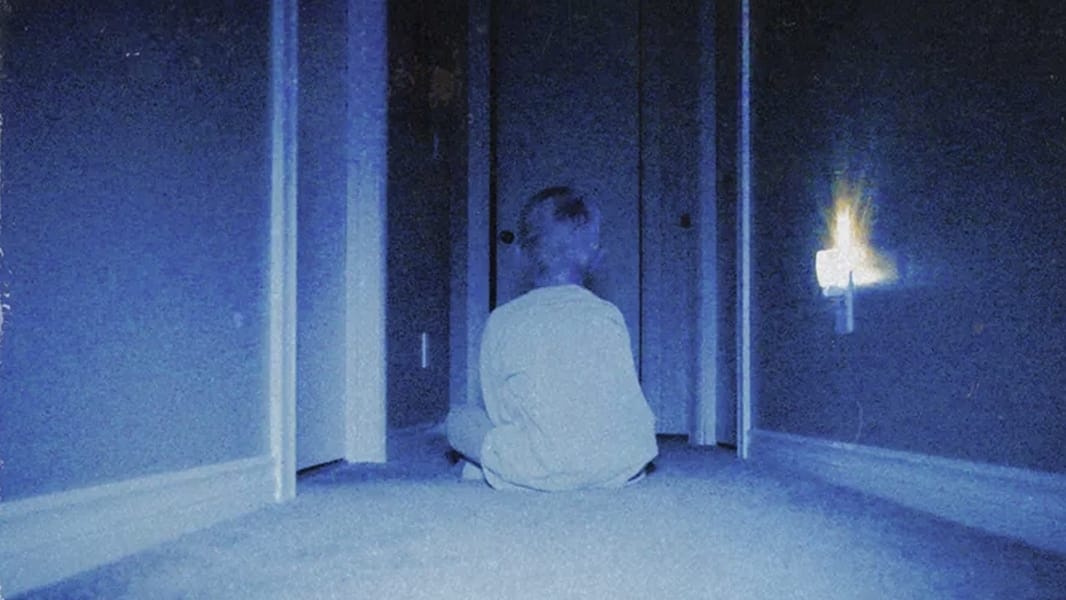‘Skinamarink’ and Creeping, Dreadful Minimalism
The cult horror film’s dreamy, nightmarish minimalism makes you wonder, what even is story anyway?
NEW STANDARD DISCLAIMER: This newsletter aggressively spoils things.
I have watched Skinamarink and I have regrets1. These regrets are mainly along the lines of I will never sleep again and why did I watch pure nightmare fuel, not necessarily for having given over an hour and a half of my life to this film.
If you haven’t seen Skinamarink, none of this will make sense to you. If you have seen Skinamarink, it probably won’t make sense either. This is a lo-fi, abstract horror movie that made some waves when it was released because of its deliberately and aggressively dream-like presentation—it’s shot on digitally grainy film in extreme darkness2, from odd and usually very low angles, and rarely has any of the characters centered in the shot. Everything is off-kilter, it’s impossible to make out much of the setting, and so hard to hear the dialog it is frequently—but inconsistently—subtitled.
The premise is simple: Two siblings, four-year-old Kevin and six-year-old Kaley, wake up one evening to discover their father is gone (their mother is apparently already gone, though the circumstances are murky), and windows and doors seem to be disappearing. As they make their way through an increasingly unfamiliar house they become aware of a presence that calls out to them and have a series of increasingly disturbing encounters3.
It’s a weird film. One of the weirdest aspects of it is its approach to story—you get precious little concrete information, and yet it is possible to piece together something of a narrative. This pushed me to ponder the question: How little information can you give an audience and still call it a story4?
Where Did They Go?
Skinamarink doesn’t have anything even close to a traditional narrative. The movie starts off with a disorienting series of shots that imply someone has been injured, and then the father has a phone call in which he admits his son has fallen and hit his head, but assures the other person on the line that they went to the hospital and all is well. That’s it for traditional exposition; from this point forward the story is “told” via interpretation more than anything else5.
It’s possible to construct a version of events based on the slim facts we know (the mother was already gone before the film began, Kevin suffered some sort of head injury, a disappearing toilet is a big deal, the cartoons that play endlessly on the television are vintage [actually, public domain] and slightly creepy). While you can never be certain if your interpretation is “correct,” you can indeed piece together a narrative. For example, here’s one: Kevin and Kaley’s mother committed suicide because their father was abusing them. After Kevin’s head injury he lies in a coma and everything that we see is in his feverish memory of his father calling the children upstairs and instructing them to “behave” themselves.
Is that the story? You can’t know. But considering the fact that this movie is 95% mood and vibe and only 5% facts and actions6, the fact that you can actually pick out a potential storyline here is both impressive and a tribute to the brain’s pattern-creating powers.
Problem Solved
Our brains are amazing machines, and they will absolutely craft a storyline from a few random pieces of string and a strong smell of ammonia. Writers draft on this all the time7, trusting that readers will simply fill in the blanks—that’s essentially how the Hand Wave works: You simply write “Somehow, Palpatine came back8” and the audience furrows their brow, their brain furiously processes for ten seconds, and then a full-on back story blooms in their heads and you get to chortle to yourself as you count your pennies.
Stories like the one in Skinamarink rely on this. Whether or not there’s a canonical storyline in the writer’s head, the film trusts that with some minimal information you will decide what’s going on, and chances are what you imagine to be the true story will be more terrifying than anything they came up with, anyway.
This is harder to pull off in writing than in visual media, of course. A lot of folks have compared Skinamarink to Mark Z. Danielewski’s novel House of Leaves and while this is true in terms of mood and vibe and raw circumstance, the novel can’t get away with the same level of hollow vibing—there are literal tons of detail in House of Leaves, even if it lacks a definitive through-line. Skinamarink can get away with a 5-minute sequence where a cartoon repeats itself over and over, and when the cartoon’s music repeats later you’re free to puzzle up some connections and nail some narrative structure into place. But in a novel, writing “THE MUSIC FROM PAGE 344 REPEATS” followed by three blanks pages implying that you ought to be sketching out your concepts for what’s going on is not going to be welcomed9.
But different mediums have different rules, and writing for a screen is different than writing a novel. Skinamarink succeeds in what it set out to do: Present a terrifying story without ever being literal, obvious, or particualrly clear about what’s happening10. Being forced to figure out what’s happening is a form of collaboration, and it’s not wrong to say that the audience is tasked with real work when watching this film. But that also means that no one will experience Skinamarink exactly the same: People will bring different traumas, childhood memories, and tolerance for the film’s specific tricks, and that means everyone will have an individual experience. It’s actually kind of magic.
What did I bring to the story? I’m not sure, as I blacked out and woke up weeping in my childhood bed. The new owners were not amused11.
Next week: We can also discuss songs here, dammit.
Then again, I’m middle-aged. Regrets are all I have left. Well, regrets and sweet, sweet whiskey … which just generates more regrets. I may be a perfect organism.
Someone online claims you can see the filter providing the grain repeat itself if you pay attention, which leads to the question of what you’re doing with your life if that’s how you spend your time. Then again, I write essays about movies no one has seen, so who’s winning here?
"A Series of Disturbing Encounters” is the perfect title of my memoir, actually. My whole life has been defined by people freaking me out and me freaking out other people.
Similarly, I have been living an experiment known as “how short can shorts be before they no longer count as pants?”
Similar to the way I rely on interpretation to order my 16th whiskey of the night, largely through interpretive dance and hair flips.
This also describes me, which is why I am so much fun to go drinking with.
I dream of the day I can write a series of vague images and someone pays me $10,000 to publish it. Instead all I get is a series of angry admonitions that “this isn’t a story, it’s a shopping list” or “this isn’t a story, it’s a doodle of a chicken wearing a Flava Flav-style clock” or “this isn’t a story it’s a blank sheet of paper.” Editors are picky, y’all.
I predict that in the future this phrase will replace “fuck you” as an all-purpose epithet.
Although that does somewhat capture the experience of reading House of Leaves.
As a writer, my main superpower is to look confused when someone says they don’t understand my story and suggest that they’re just not smart, while feverishly trying to gague just how drunk I was when I wrote it. Spoiler: I was almost always really, really drunk.
When I asked them why they had my childhood bed, however, things got awkward and we all agreed to just let it go.







The bartender’s calculation is, “Which whiskey do I give him for free to get him to stop dancing?” The answer, of course, is, “It doesn’t matter.”
I really think you missed the boat in not titling your memoir "I May Be the Perfect Organism."